Payments, Power of Payments Podcast
Power of Payments Ep. 15: ‘Regulators don’t hate BNPL — they just want more consumer protection’: Citizens Pay’s Gaurav Sethi
- Gaurav Sethi, chief strategy officer at Citizens Pay, joins host Ismail Umar on this week’s podcast.
- He talks about how being a bank-owned BNPL provider differentiates Citizens Pay from competitors, how the current macroeconomic climate is impacting BNPL firms, and what increased regulation would look like for the sector.








